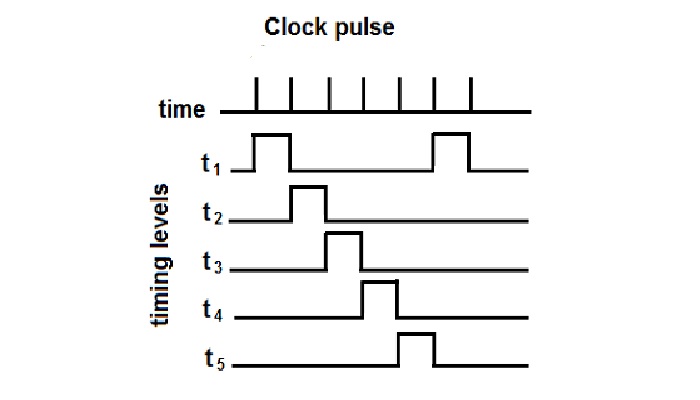In This Article
What is Clock Pulse?
A clock pulse, also referred to as CP sometimes, indicates the vibration of the quartz crystal found inside a computer. The primary function of it is to synchronize the different timings of different hardware components.
In technical terms, a clock pulse in a computer, like in all other synchronous digital circuits and electronics, signifies the oscillation between a high state and a low state.
The different actions of the digital circuits are coordinated by using this pulse as a metronome.
KEY TAKEAWAYS
- The clock pulses are continuous and are actually the changes in voltage that are spaced precisely.
- Usually generated by a clock generator, clock pulses are in the form of a square wave signal with a 50% duty cycle.
- The purpose of the clock pulse is to help in synchronizing the operations of the computer system.
- When there is a series of clock pulses it also helps in transferring the charges buildup to a digital output flow.
- The clock pulse is effectively distributed to every part of a chip with a lowest skew that needs it and is best done by a metal grid.
Understanding Clock Pulse

In simple words, the number of clock pulses in one second determines the speed of the processor of a computer, which is usually measured in Megahertz or Gigahertz.
It basically signifies the changes in the voltages inside, or between the high and low states within the circuit.
Though there may be more complex arrangements to generate a clock pulse, it is typically generated by the clock generator. It is usually a square wave signal with a 50% duty cycle.
The clock pulses typically have a constant frequency and the circuits that use it become active during the rising edge or during the falling edge.
However, it can also be used in both rising and falling edges, as it is in double data rate.
Clock pulses are necessary for most of the Integrated Circuits or ICs with ample complexity for synchronizing different parts of them, such as the microprocessors in the computer, which are quite complex chips.
Moreover, different types of circuits may use different types of clock signals in different phases. For example:
- Most synchronous circuits these days use a single-phase clock where the pulses or signals are sent through a single wire
- A few synchronous circuits may use a two-phase clock in which non-overlapping pulses are distributed through two wires and
- Some early microprocessors and ICs used four-phase logic needing to use a four-phase clock input that had four different and non-overlapping clock pulses.
A few mixed-signals, sensitive and precision circuits such as the Analog to Digital Converters use sine waves as clock pulses rather than square waves.
This is because these waves contain harmonics of high frequency which may cause noise due to their interference with the analog circuitry.
The clock pulses are distributed by the clock distribution network to all the parts that need them from one common point.
These pulses usually function at a high speed and are loaded with the highest fan-out.
These waveforms need to be very sharp and clean so that they are not affected in any way due to technology scaling or Moore’s Law.
Typically, uncertain and non-continuous clock pulses can limit the optimal performance of the CPU and the entire system resulting in calamitous race conditions wherein incorrect data signals may be latched in a register.

What is the Use of Clock Pulse?
The primary use of a clock pulse is to synchronize and coordinate the different operations of an IC or an electronic system and to know when and how to carry out the programmed functions.
In other words, this helps in retaining the output signals during a transition according to the values of the input signals at the rising edge, or at the falling edge, or both depending on the type of the circuits.
Typically, the microcontrollers need to use clock pulses especially because they are dependent on the clock source.
Ideally, apart from the processor itself, the buses as well as the peripherals all need to use the clock pulses for synchronizing their respective operations.
Since this determines the speed at which the processor can carry out an instruction, it is essential for its performance.
How Does a Clock Pulse Work?
The working process of the clock pulses involves generating them with a clock generator or a frequency meter by using a crystal controlled, high-stability oscillator which are then counted and passed through the logic gates.
The entire working process includes the following steps:
- Generating the clock pulses that are usually at a higher frequency
- Holding a voltage at the input
- Passing he pulses through the gate
- Counting them
- Sending them as an input to the integrator and
- Raising the output voltage.
Typically, the counting of the clock pulses, also called the 1/T interpolation method, helps in measuring the precise timings in which transitions in the encoder occur, which further helps in increasing the resolution.
Types of Clock Pulse
Different types of clock pulses are generated and used by different types of circuits such as amplitudes, impedance semiconductors, transistors, flip-flop circuits, amplifiers, resistors, and oscillators.
Questions & Answers:
How is a Clock Pulse Generated?
A clock pulse is usually generated by a clock generator in a square waveform with a 50% duty cycle. The fundamental parts of the clock generator share an amplifier and a resonant circuit while generating these fixed signals.
How Many Clock Pulses are Required?
Usually, only one clock pulse is required by one shift register to load a bit. This means that as many as 5 clock pulses will be needed by a 5-bit shift register to load a bit.
What is Negative Clock Pulse?
Usually, the clock pulses always move from either a 0 to 1 of a signal and then from 1 to 0, therefore making two transitions in one single signal.
When the clock pulses move from 1 to 0 of a signal it is called a negative clock pulse and when it moves from 0 to 1 it is called a positive transition.
What is Clock Pulse Width?
The clock pulse width typically refers to the time elapsed between the trailing and leading edges considering one single pulse of energy.
Ideally, it ensures that the clock signal flow is adequate to help the circuits to complete any operation. It should be of a fixed minimum width, at least, to receive a constant output at the clock pin.
Conclusion
Clock pulses are vital for the performance of the CPU and the whole computer system.
It allows synchronous system operation with proper distribution of it to all the parts that need it depending on their characteristics and the electrical networks used.